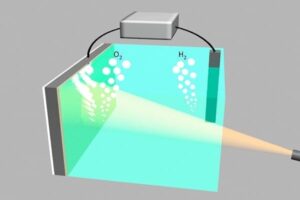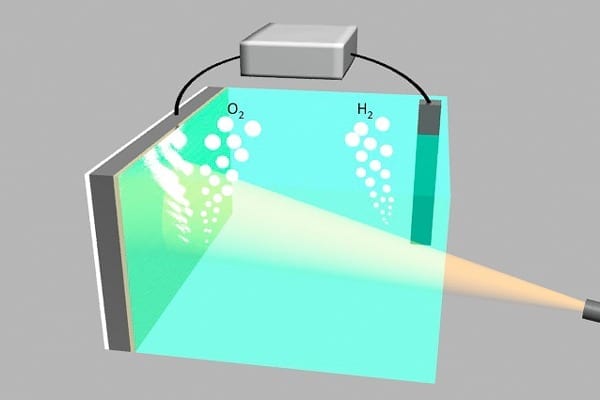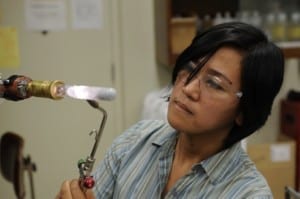
Stanford researchers have developed an inexpensive device that uses light to split water into oxygen and clean-burning hydrogen.
The goal is to supplement solar cells with hydrogen-powered fuel cells that can generate electricity when the sun isn’t shining or demand is high.
Stanford University scientists have created a silicon-based water splitter that is both low-cost and corrosion-free. The novel device – a silicon semiconductor coated in an ultrathin layer of nickel – could help pave the way for large-scale production of clean hydrogen fuel from sunlight, according to the scientists. Their results are published in the Nov. 15 issue of the journal Science.
“Solar cells only work when the sun is shining,” said study co-author Hongjie Dai, a professor of chemistry at Stanford. “When there’s no sunlight, utilities often have to rely on electricity from conventional power plants that run on coal or natural gas.”
A greener solution, Dai explained, is to supplement the solar cells with hydrogen-powered fuel cells that generate electricity at night or when demand is especially high.
To produce clean hydrogen for fuel cells, scientists have turned to an emerging technology called water splitting. Two semiconducting electrodes are connected and placed in water. The electrodes absorb light and use the energy to split the water into its basic components, oxygen and hydrogen. The oxygen is released into the atmosphere, and the hydrogen is stored as fuel.
When energy is needed, the process is reversed. The stored hydrogen and atmospheric oxygen are combined in a fuel cell to generate electricity and pure water.
The entire process is sustainable and emits no greenhouse gases. But finding a cheap way to split water has been a major challenge. Today, researchers continue searching for inexpensive materials that can be used to build water splitters efficient enough to be of practical use.
Silicon solution
“Silicon, which is widely used in solar cells, would be an ideal, low-cost material,” said Stanford graduate student Michael J. Kenney, co-lead author of the Science study. “But silicon degrades in contact with an electrolyte solution. In fact, a submerged electrode made of silicon corrodes as soon as the water-splitting reaction starts.”
In 2011, another Stanford research team addressed this challenge by coating silicon electrodes with ultrathin layers of titanium dioxide and iridium. That experimental water splitter produced hydrogen and oxygen for eight hours without corroding.
“Those were inspiring results, but for practical water splitting, longer-term stability is needed,” Dai said. “Also, the precious metal iridium is costly. A non-precious metal catalyst would be desirable.”
To find a low-cost alternative, Dai suggested that Kenney and his colleagues try coating silicon electrodes with ordinary nickel. “Nickel is corrosion-resistant,” Kenney said. “It’s also an active oxygen-producing catalyst, and it’s earth-abundant. That makes it very attractive for this type of application.”
Go deeper with Bing News on:
Low-cost water splitter
- Novel PV-driven desalination tech achieves lower levelized cost of water
Scientists led by the Massachusetts Institute of Technology (MIT) have designed a new PV-powered desalination system based on the time-variant electrodialysis reversal (EDR) technology. The proposed ...
- You'll Never Have Problems With Your Hose Again With These Genius Hacks
A garden hose is a versatile tool that simplifies many outdoor tasks. However, it can be challenging to deal with issues like leaks, kinks, and tangles that can quickly turn everyday chores into ...
- Best CPU coolers in 2024
Instead, for a cleaner-looking build and an easier installation, all-in-one (AIO) water coolers are your ... generations of Noctua coolers. Its cable splitter helps you to avoid clutter, and ...
- How Much Does A Tankless Water Heater Cost In 2024?
Tankless water ... as low as 40° F. The amount of temperature rise needed in your area can influence the type of tankless water heater you need. Several things can affect the total cost of ...
- These home electrification and efficiency improvements could cut costs and carbon | Opinion
If your panel is rated at 100 amps or more, an expensive upgrade can be avoided if you start by weatherizing your home, identifying and plugging leaks, and adding insulation where it is thin.
Go deeper with Google Headlines on:
Low-cost water splitter
[google_news title=”” keyword=”Low-cost water splitter” num_posts=”5″ blurb_length=”0″ show_thumb=”left”]
Go deeper with Bing News on:
Water splitting
- Water treatment specialist SurfCleaner supplies Norwegian energy giant Equinor
Swedish firm SurfCleaner has delivered a full ATEX SCO 1000 system to Eqinor’s Kårstø processing plant in Nord-Rogaland, the largest of its kind in Europe.
- Why no one won in this year’s water wars
Westlands Water District, which gets its water from the CVP ... down all commuter travel and most freight movement for nearly two months. — Ag groups are split over a bill by Assemblymember Joaquin ...
- GOP split could doom bipartisan child tax credit bill
A bipartisan group is trying to push legislation to cut taxes for working families and some corporations into law, but it faces stiff opposition.
- As court overturns a lot-splitting law, SB 9, one early adopter asks why
After an L.A. County judge declared SB 9 unconstitutional, Sam Andreano, who took advantage of the program by splitting his Whittier property in half, is wondering why.
- New EPA regulations target air, water, land and climate pollution from power plants, especially those that burn coal
The first rule updates the Clean Air Act’s 2012 Mercury and Air Toxics Standards. Mercury, which is emitted into the air when coal is burned, is a neurotoxin that causes developmental damage in ...
Go deeper with Google Headlines on:
Water splitting
[google_news title=”” keyword=”water splitting” num_posts=”5″ blurb_length=”0″ show_thumb=”left”]











